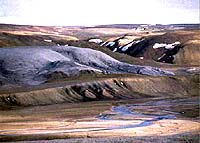| . |  |
. |
|
by Janet Wong  Toronto - January 26, 2000 - If humans were to inhabit Mars, how would we do it? What would we need to know? How would we breathe, eat, sleep, communicate, interact and live?
Toronto - January 26, 2000 - If humans were to inhabit Mars, how would we do it? What would we need to know? How would we breathe, eat, sleep, communicate, interact and live?University of Toronto geology graduate student Darlene Lim is among a team of scientists on the Haughton Mars Project asking, and answering, those very questions. This project, led by the National Aeronautics and Space Administration, will be conducted on Haughton Crater on Devon Island in the Canadian high Arctic. According to Lim, the similarity of this crater to Mars is quite remarkable. Its geography, topography and potential microbiology may be comparable to those of the Red Planet since there is evidence that Mars once had crater lakes similar to the ancient lake that once occupied Haughton Crater. "By and large, the Haughton Mars Project explores how we would explore Mars," Lim says. "We have to know what to look for to see if there ever was life on Mars. And we also have to be conscious so that our activities do not destroy what we intend to study." A two-level habitat is being built and tested in Colorado by the Mars Society (a private group committed to the exploration and settlement of Mars). This simulated Mars space station -- which sleeps up to six people -- will have its inaugural opening July 20 on Haughton Crater and two groups will reside there for one week each this summer. As the project progresses through the years, the plan is to have people staying in the habitat for longer periods of time, says Lim, who is also a Mars Society member. "The science and research gathered will be extremely useful -- from earth sciences research to robotics testing on rough terrain, from space communication to the social aspects of living in extreme conditions," she notes.
"This project is a feasibility study and will give us a lot of information on what we need to know before we can send human explorers to Mars," added Lim.
EARTH INVADES MARS
|
| |||||||||
| The content herein, unless otherwise known to be public domain, are Copyright 1995-2016 - Space Media Network. All websites are published in Australia and are solely subject to Australian law and governed by Fair Use principals for news reporting and research purposes. AFP, UPI and IANS news wire stories are copyright Agence France-Presse, United Press International and Indo-Asia News Service. ESA news reports are copyright European Space Agency. All NASA sourced material is public domain. Additional copyrights may apply in whole or part to other bona fide parties. Advertising does not imply endorsement, agreement or approval of any opinions, statements or information provided by Space Media Network on any Web page published or hosted by Space Media Network. Privacy Statement All images and articles appearing on Space Media Network have been edited or digitally altered in some way. Any requests to remove copyright material will be acted upon in a timely and appropriate manner. Any attempt to extort money from Space Media Network will be ignored and reported to Australian Law Enforcement Agencies as a potential case of financial fraud involving the use of a telephonic carriage device or postal service. |